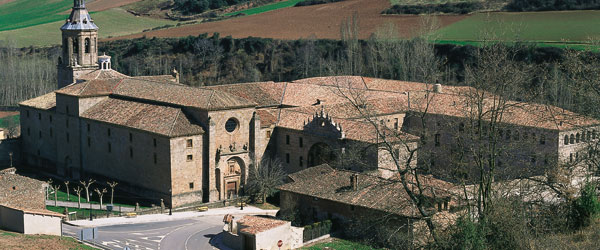The route of the monasteries, the cradle of the Castilian language
The monasteries that stand in or near the Najerilla River valley (La Rioja) are exceptional for their beauty, their diversity of artistic styles and their historical importance. These institutions arose in the Middle Ages and were of paramount importance in the birth of the Castilian language and in the transmission of knowledge in the more benighted periods of history. Furthermore, most of these buildings stand in natural settings of exceptional ecological value and spectacular beauty, and are well dedicating some time for a leisurely visit.
At a distance of 14 kilometres from Anguiano in the foothills of the mountains of San Lorenzo and set in a magnificent landscape of oak, beech and pine forests, stands the Benedictine monastery of Valvanera, home to the image of the patron saint of La Rioja, the Virgin of Valvanera, and thus a point of encounter for Marian pilgrimages.
The original monastery was built in the 9th century although today the whole site has been refurbished. The church, dating from the 15th century, is well worth a thorough visit, as is the library, which contains numerous valuable books including particularly a 10th-century illuminated codex.
San Millán de la Cogolla is the site of the monastic ensemble of Suso (or the upper monastery) and Yuso (the lower), two of the most famous of this type of institutions in La Rioja, and awarded the UNESCO World Heritage designation in 1997.
The first and most primitive, Suso, has its origins in the 6th century, although it underwent refurbishments and extensions until the 11th century. It was originally a simple collection of caves that served as refuge for the hermits, to which was later added a church with two naves separated by three horseshoe arches. The gallery in the cloister is the site of the tombs of the seven infantes of Lara, and three queens of Navarre.
Its scriptorium is the place where the first words conserved in the Castilian language were written, in what are known as the Glosas Emilianenses (10th century), when an anonymous copyist noted the vernacular meaning of certain Latin words in the margins or between the lines of the codex. In the 13th century, Gonzalo de Berceo also penned part of his work in this monastery
Descending into the valley, Yuso, the second monastery in the ensemble, was built in 1053 under the reign of García Sánchez of Navarre. Its most interesting feature is the Gothic cloister, the church –dating from the 16th century and built with three naves, a transept and an oval dome–, the sacristy, the Hall of the Kings, the museum –containing major works of art (relics, chests…)–, and the library, with an important collection of incunabula and parchments, in addition to a facsimile copy of the Glosas Emilianenses.
Like Yuso, Santa María la Real in Nájera was also built by the king Don García in the mid 11th century, with part of the plunder obtained from the conquest of Calahorra. It was rebuilt in the 15th century, which is the reason for the predominance of Gothic and Renaissance style.
Highlights include the 17th century prismatic tower and the cylindrical buttresses that give the structure the appearance of a fortress. On the interior, the choir stalls are magnificent examples of the Isabelline style. The Los Caballeros cloister, in the Gothic style and built in the first half of the 16th century, owes its name to the fact that it was the burial site of numerous members of the nobility. It is also home to the sarcophagus of the knight Garcilaso de la Vega, who died in 1367 in the battle of Nájera, and also to the mausoleum of Don Diego López de Haro. Lastly, the pantheon contains the remains of several kings of Navarre. The Romanesque tombstone of Doña Blanca is exceptionally beautiful.
Also in the town of Nájera stands the monastery of Santa Elena, well worth visiting for the high altar and the choir stalls in its church.
The next landmark on the route is the monastery of Santa María del Salvador in Cañas, the birthplace of Santo Domingo de Silos. This is one of the most interesting examples of Cistercian architecture in Spain an was built in the 13th century by Doña Urraca López de Haro.
Its light and airy 12th century church consists of three sections, a transept and three apses. In the chapter room stands a large column in the shape of a palm tree, whose branches spread towards the four sections of ribbing supporting the vault. The windows are decorated with floral motifs.
Although they lack the artistic and historic value of the previous monasteries, a more leisurely visit to the region of La Rioja should definitely include a stop at the monasteries of San José (Calahorra), Santa María de la Estrella (San Asensio), La Piedad (Casalarreina), La Anunciación (Santo Domingo de la Calzada) and Vico (Arnedo).







